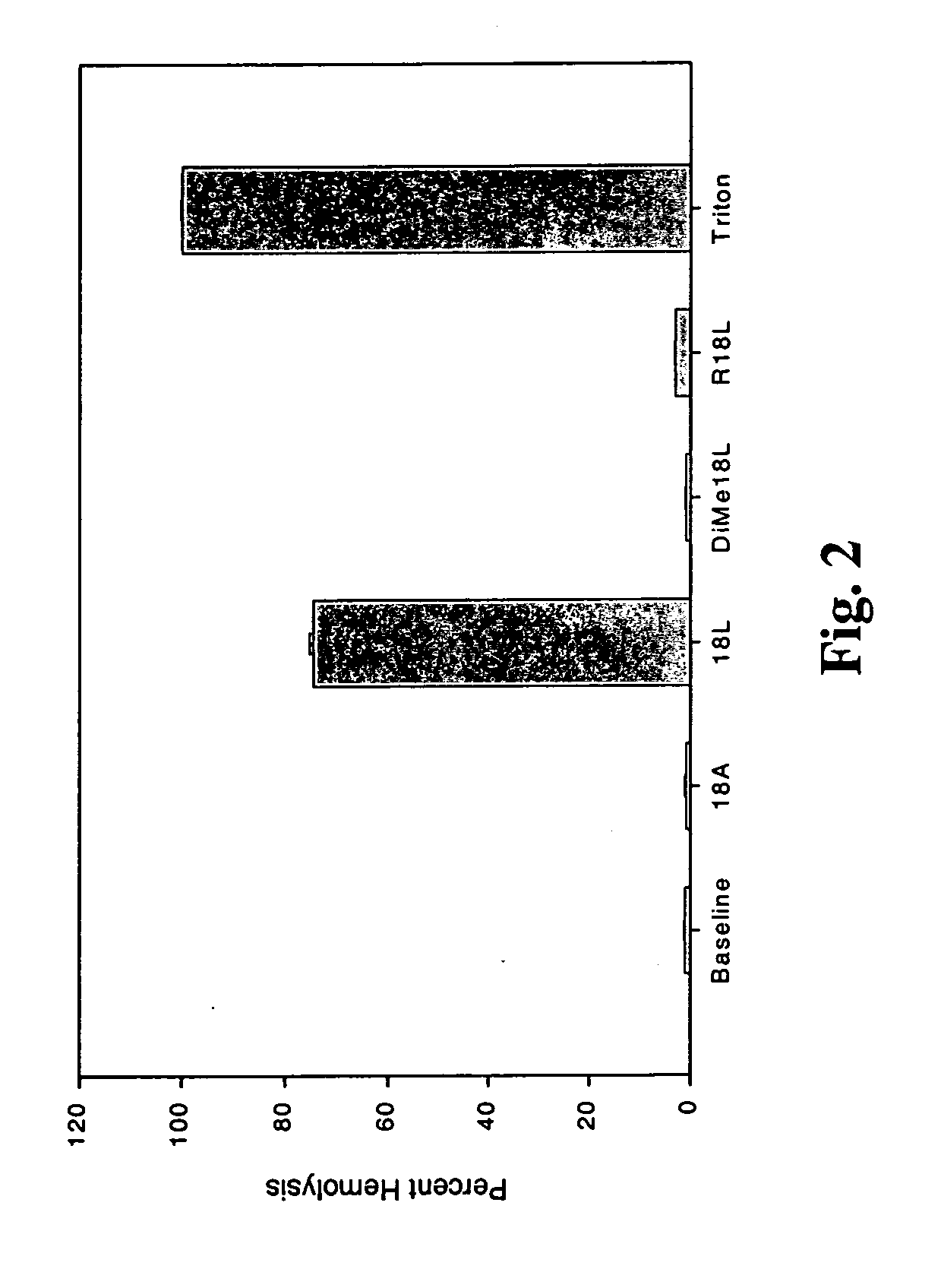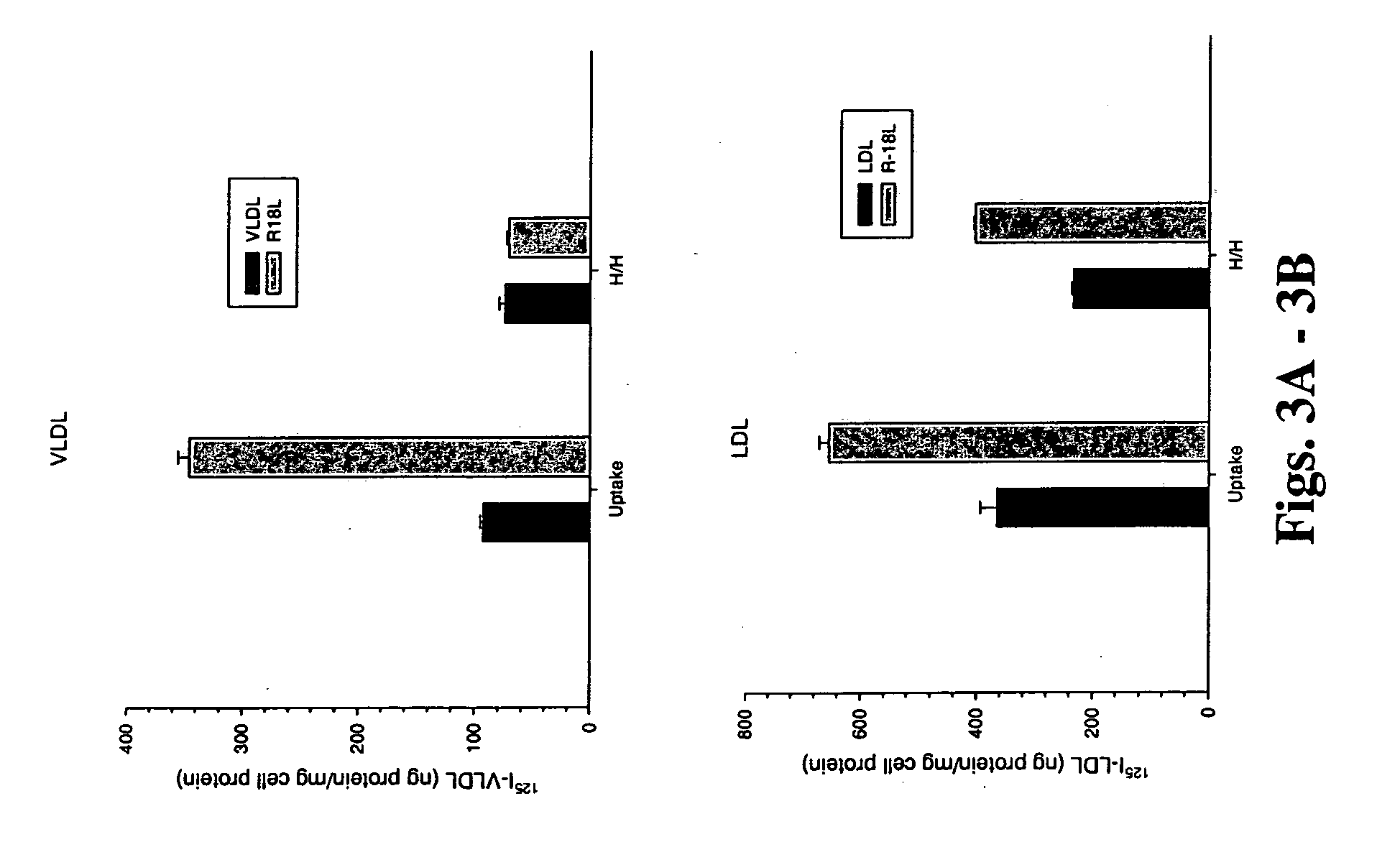Synthetic single domain polypeptides mimicking apolipoprotein E and methods of use
a single-domain polypeptide and polypeptide technology, applied in the field of synthetic single-domain polypeptides mimicking apolipoproteins, can solve the problems of increasing plasma cholesterol levels, increasing oxidative stress, increasing the risk of atherosclerosis, etc., to reduce the risk of stroke, improve the cellular uptake of serum cholesterol, and reduce the risk of plaque formation
- Summary
- Abstract
- Description
- Claims
- Application Information
AI Technical Summary
Benefits of technology
Problems solved by technology
Method used
Image
Examples
example 1
Single Amphipathic Helical Structure Containing Arg Residue on Polar Face of Helix Associates with Lipid and Enhances Lipid Uptake
[0124] The molecular modeling shown in FIGS. 1A-1F was performed to determine the nature of the helical structure of the single domain peptide of the invention given changes to the residues internal to the helix. Computer software useful to carry out the molecular modeling includes programs called WHEEL, LOCATE, HELNET described in M. K. Jones, G. M. Anantharamaiah, and J. P. Segrest; “Computer programs to identify and classify amphipathic α helical domains”J. Lipid Res. 33:287-296, 1992.
[0125] Experiments were designed to determine whether modulation of the atherogenic lipoprotein surface with positively charged residues would alter LDL binding to cell surface proteoglycans and lipoprotein uptake by the cells. Peptides were synthesized to alter residues on the atherogenic lipoprotein surface by increasing the positively charged residues there. Sequence...
example 2
Dimethylation of Lysine in the 18L Peptide Neutralizes the Hemolytic Property of the 18L Peptide
[0128] This example was performed to test the affect of amino acid residue changes on the lytic nature of peptides of the invention. Lysine residues, which resided on the polar face of the single domain peptide, were substituted with arginine and such altered peptides were tested for lytic ability. Similarly, in other peptides of the invention, lysine residues on the polar face of the single domain peptide of the invention were dimethylated. These altered peptides neutralized the hemolytic property of the 18 L peptide. A suspension of erythrocytes (106 cells / ml) in phosphate-buffered saline with and without peptide (10 ml of 100 mM peptide solution) was incubated for 10 min at 37° C. Hemolysis was expressed as hemoglobin content (absorbance at 540 nm) of the supernatant after centrifugation at 16,000×g for 3 min. Hemoglobin content as measured in the presence of 0.1% Triton X-100 was tak...
example 3
Effects of Analogs of the R-18L Peptide and Effects of Different Peptide Length on Lipoprotein Uptake
[0133] These experiments were performed to test shorter analogs of the peptides of the invention and their ability to facilitate and enhance lipoprotein uptake by cells. In this example, two 14-residue analogs of (R) 18L (14—residue single domain pepetides) were designed and synthesized. The (R) 18L peptide has the following sequence: Ac-(R)18L-NH2: GIRRFLGSIWRFIRAFYG (SEQ ID NO:10). One analog has the four C-terminal residues deleted and has the following sequence: Ac-(R)14L-NH2 analog 1: GIRRFYGSIWRFIR (SEQ ID NO:11). Another analog has two residues each deleted from the N-terminal and the C-terminal as follows: Ac-(R)14L-NH2 analog 2: —RRFYGSIWRFIRAF (SEQ ID NO:12). As shown in FIGS. 8A-8B, the R-14L-2 peptide but not the R-14-L-1 peptide enhanced the uptake of LDL in vitro. The peptide R-14L-2 but not R-14L-1 was also effective in decreasing plasma cholesterol in Apo E null mice...
PUM
| Property | Measurement | Unit |
|---|---|---|
| time | aaaaa | aaaaa |
| time | aaaaa | aaaaa |
| flow rate | aaaaa | aaaaa |
Abstract
Description
Claims
Application Information
 Login to View More
Login to View More - R&D
- Intellectual Property
- Life Sciences
- Materials
- Tech Scout
- Unparalleled Data Quality
- Higher Quality Content
- 60% Fewer Hallucinations
Browse by: Latest US Patents, China's latest patents, Technical Efficacy Thesaurus, Application Domain, Technology Topic, Popular Technical Reports.
© 2025 PatSnap. All rights reserved.Legal|Privacy policy|Modern Slavery Act Transparency Statement|Sitemap|About US| Contact US: help@patsnap.com



